1.
Introduction
Chemotaxis is the property of cells to move in an oriented manner in response to an increasing concentration of chemo-attractant or decreasing concentration of chemo-repellent, where the former is referred to as attractive chemotaxis and the later to repulsive chemotaxis. To begin with, it is important to study the quasilinear Keller-Segel system as follows
subject to homogeneous Neumann boundary conditions, where the functions D(u) and ϕ(u) denote the strength of diffusion and chemoattractant, respectively, and the function u=u(x,t) idealizes the density of cell, v=x(x,t) represents the concentration of the chemoattractant. Here the attractive (repulsive) chemotaxis corresponds to χ>0 (χ<0), and |χ|∈R∖{0} measures the strength of chemotactic response. The parameters τ∈{0,1}, and α,β>0 denote the production and degradation rates of the chemical. The above system describes the chemotactic interaction between cells and one chemical signal (either attractive or repulsive), and it has been investigated quite extensively on the existence of global bounded solutions or the occurrence of blow-up in finite time in the past four decades. In particular, the system (1.1) is the prototypical Keller-Segel model [1] when D(u)=1,ϕ(u)=u. In the case τ=1, there are many works to show that the solution is bounded [2,3,4,5], and blow-up in finite time [6,7,8,9,10,11]. If the cell's movement is much slower than the chemical signal diffusing, the second equation of (1.1) is reduced to 0=Δv−M+u, where M:=1|Ω|∫Ωu(x,t)dx and the simplified system has many significant results [12,13,14,15].
For further information concerning nonlinear signal production, when the chemical signal function is denoted by g(u), authors derived for more general nonlinear diffusive system as follows
where M:=1|Ω|∫Ωg(u(x,t))dx. Recently, when D(u)=u−p,ϕ(u)=u and g(u)=ul, it has been shown that all solutions are global and uniformly bounded if p+l<2n, whereas p+l>2n implies that the solution blows up in finite time [16]. What's more, there are many significant works [17,18,19] associated with this system.
Subsequently, the attraction-repulsion system has been introduced in ([20,21]) as follows
subject to homogeneous Neumann boundary conditions, where χ,ξ,α,β,δ,γ>0 are constants, and the functions u(x,t),v(x,t) and w(x,t) denote the cell density, the concentration of the chemoattractant and chemorepellent, respectively. The above attraction-repulsion chemotaxis system has been studied actively in recent years, and there are many significant works to be shown as follows.
For example, if τ1=τ2=0, Perthame [22] investigated a hyperbolic Keller-Segel system with attraction and repulsion when n=1. Subsequently, Tao and Wang [23] proved that the solution of (1.3) is globally bounded provided ξγ−χα>0 when n≥2, and the solution would blow up in finite time provided ξγ−χα<0,α=β when n=2. Then, there is a blow-up solution when χα−ξγ>0,δ≥β or χαδ−ξγβ>0,δ<β for n=2 [24]. Moreover, Viglialoro [25] studied the explicit lower bound of blow-up time when n=2. In another hand, if τ1=1,τ2=0, Jin and Wang [26] showed that the solution is bounded when n=2 with ξγ−χα≥0, and Zhong et al. [27] obtained the global existence of weak solution when ξγ−χα≥0 for n=3. Furthermore, if τ1=τ2=1, Liu and Wang [28] obtained the global existence of solutions, and Jin et al. [29,30,31] also showed a uniform-in-time bound for solutions. In addition, there are plenty of available results of the attraction-repulsion system with logistic terms [32,33,34,35,36,37,38,39,40], and for further information concerning (1.3) based on the nonlinear signal production, it was used to model the aggregation patterns formed by some bacterial chemotaxis in [41,42,43].
We turn our eyes into a multi-dimensional attraction-repulsion system
where Ω∈Rn(n≥2) is a bounded domain with smooth boundary, μ1(t)=1|Ω|∫Ωf(u)dx,μ2(t)=1|Ω|∫Ωg(u)dx and τ1,τ2∈{0,1}. Later on, the system (1.4) has attracted great attention of many mathematicians. In particular, when ϕ(u)=ψ(u)=u,f(u)=uk and g(u)=ul, Liu and Li [44] proved that all solutions are bounded if k<2n, while blow-up occurs for k>l and k>2n in the case τ1=τ2=0.
Inspired by the above literature, we are devoted to deal with the quasilinear attraction-repulsion chemotaxis system
in a bounded domain Ω⊂Rn,n≥2 with smooth boundary, where ∂∂ν denotes outward normal derivatives on ∂Ω. The function u(x,t) denotes the cell density, v(x,t) represents the concentration of an attractive signal (chemo-attractant), and w(x,t) is the concentration of a repulsive signal (chemo-repellent). The parameters satisfy χ,ξ≥0, which denote the strength of the attraction and repulsion, respectively. Here μ1(t)=1|Ω|∫Ωf1(u(x,t))dx, μ2(t)=1|Ω|∫Ωf2(u(x,t))dx, and f1,f2 are nonnegative Hölder continuous functions.
In the end, we propose the following assumptions on D,f1,f2 and u0 for the system (1.5).
(I1) The nonlinear diffusivity D is positive function satisfying
(I2) The function fi is nonnegative and nondecreasing and satisfies
with i∈{1,2}.
(I3) The initial datum
The goal of the article is twofold. On the one hand, we need to find out the mutual effect of the nonlinear diffusivity D(u) and the nonlinear signal production fi(u)(i=1,2). On the other hand, we need to make a substantial step towards the dynamic of blowing up in finite time. Hence, we draw our main results concerning (1.5) read as follows.
Theorem 1.1. Let n≥2, R>0 and Ω=BR(0)⊂Rn be a ball, and suppose that the function D satisfies (1.6) and f1,f2 are assumed to fulfill (1.7) as well as
with m∈R, k1,k2,γ1,γ2,d>0 and
For any M>0 there exist ε=ε(γ1,M,R)∈(0,M) and r∗=r∗(γ1,M,R)∈(0,R) such that if u0 satisfies (1.8) with
then the corresponding solution of the system (1.5) blows up in finite time.
Theorem 1.2. Let n≥2, Ω⊂Rn be a smooth bounded domain, and suppose that the function D satisfies (1.6) and f1,f2 are assumed to fulfill (1.7) as well as
with m∈R, k1,k2,γ1,γ2,d>0 and
Then for each u0∈⋃θ∈(0,1)Cθ(¯Ω), u0≥0 with ∂u0∂ν=0 on ∂Ω, and the system (1.5) admits a unique global classical solution (u,v,w) with
Furthermore, u,v and w are all non-negative and bounded.
The structure of this paper reads as follows: In section 2, we will show the local-in-time existence of a classical solution to the system (1.5) and some lemmas that we will use later. In section 3, we will prove Theorem 1.1 by establishing a superlinear differential inequality. In section 4, we will solve the boundedness of u in L∞ and prove Theorem 1.2.
2.
Preliminaries
Firstly, we state one result concerning local-in-time existence of a classical solution to the system (1.5). Then, we denote some new variables to transfer the original equations in (1.5) to a new system according to the ideas in [19,20,21,22,23,24,25]. In addition, in order to prove the main result, we will state some lemmas which will be needed later.
Lemma 2.1. Let Ω⊂Rn with n≥2 be a bounded domain with smooth boundary. Assume that D fulfills (1.6), f1,f2 satisfy (1.7) and u0∈⋃θ∈(0,1)Cθ(¯Ω) with ∂u0∂ν=0 on ∂Ω as well as u0≥0, then there exist Tmax∈(0,∞] and a classical solution (u,v,w) to (1.5) uniquely determined by
In addition, the function u≥0 in Ω×(0,Tmax) and if Tmax<∞ then
Moreover,
Finally, the solution (u,v,w) is radially symmetric with respect to |x| if u0 satisfies (1.8).
Proof. The proof of this lemma needs to be divided into four steps. Firstly, the method to solve the local time existence of the classical solution to the problem (1.5) is based on a standard fixed point theorem. Next, we will use the standard extension theorem to obtain (2.1). Then, we are going to use integration by parts to deduce (2.2). Finally, we would use the comparison principle to conclude that the solution is radially symmetric. For the details, we refer to [45,46,47,48].
For the convenience of analysis and in order to prove Theorem 1.1, we set h=χv−ξw, then the system (1.5) is rewritten as
where μ(t)=χμ1(t)−ξμ2(t)=1|Ω|∫Ωf(u(x,t))dx and f(u)=χf1(u)−ξf2(u).
For the same reason, we will convert the system (2.3) into a scalar equation. Let us assume Ω=BR(0) with some R>0 is a ball and the initial data u0=u0(r) with r=|x|∈[0,R] satisfies (1.8). In the radial framework, the system (2.3) can be transformed into the following form
Lemma 2.2. Let us introduce the function
then
and
Proof. Firstly, integrating the second equation of (2.4) over (0,r), we have
so
Then, a direct calculation yields
and
as well as
for all s∈(0,Rn) and t∈(0,Tmax).
Furthermore, by a direct calculation and (1.7), we know that the functions U and f satisfy the following results
where ωn=n|B1(0)| and A is a positive constant.
Lemma 2.3. Suppose that (1.7), (1.8) and (2.7) hold, then we have
In particular,
Proof. By integration the second equation in (2.4), we obtain that
According to (1.9), we can easily get that f(u)≥0 if u≥C∗=max{0,(k2ξk1χ)1γ1−γ2−1}, and split
Combining these we have
so we complete this proof.
To show the existence of a finite-time blow-up solution of (2.4), we need to prove that Uss is nonpositive by the following lemma. The proof follows the strategy in [48].
Lemma 2.4. Suppose that D,f and u0 satisfy (I1),(I2) and (I3) respectively. Then
Moreover,
Proof. Without loss of generality we may assume that u0∈C2 ([0,∞)) and f∈C2([0,∞)). Applying the regularity theory in ([49,50]), we all know that u and ur belong to C0([0,R]×[0,T))∩C2,1((0,R)×(0,T)) and we fixed T∈(0,Tmax). From (2.4), we have for r∈(0,R) and t∈(0,T)
and from (2.4) we obtain
for all r∈(0,R) and t∈(0,T), where
for all r∈(0,R) and t∈(0,T). Moreover, we have hr≤rn(μ(t)+C0) by (2.8) and from (2.11) such that
then setting c1:=sup(r,t)∈(0,R)×(0,T)(2f(u)+uf′(u)+C0), we obtain
and we introduce
and set c3=2(c1+c2+1). Since ur(r,t)=0 for r∈{0,R},t∈(0,T) (because u is radially symmetric) and u0r≤0, the function y:[0,R]×[0,T]→R, (r,t)↦ur(r,t)−εec3t belongs to C0([0,R]×[0,T]) and fulfills
By the estimate for y(⋅,0) in (2.12) and continuity of y, the time t0:=sup{t∈(0,T):y≤0 in [0,R]×(0,T)}∈(0,T] is defined. Suppose that t0<T, then there exists r0∈[0,R] such that y(r0,t0)=0 and y(r,t)≤0 for all r∈[0,R] and t∈[0,t0]; hence, yt(r0,t0)≥0. As D≥0 in [0,∞), not only y(⋅,t0) but also z:(0,R)→R,r⟼D(u(r,t0))y(r,t0) attains its maximum 0 at r0. Since the second equality in (2.12) asserts r0∈(0,R), we conclude zrr(r0)≤0,zr(r0)=0 and yr(r0,t0)=0. Hence, we could obtain the contradiction
since we have
So that t0=T, implying y≤0 in [0,R]×[0,T] and hence ur≤εec3t in [0,R]×[0,T]. Letting first ε↘0 and then T↗Tmax, this proves that ur≤0 in [0,R]×[0,Tmax), and we have Uss≤0 because of (2.5).
3.
Finite-time blow-up
In this section our aim is to establish a function and to select appropriate parameters such that the function satisfies ODI, which means finiteness of Tmax by counter evidence. Firstly, we introduce a moment-like functional as follows
with γ∈(−∞,1) and s0∈(0,Rn). As a preparation of the subsequent analysis of ϕ, we denote
The following lemma provides a lower bound for U.
Lemma 3.1. Let γ∈(−∞,1) and s0∈(0,Rn), then
Proof. If (3.3) was false for some t∈Sϕ such that U(s02,t)<1ωn⋅(nM−4s02γ(3−γ)), then necessarily δ:=4s02γ(3−γ)<nM. By the monotonicity of U(⋅,t) we would obtain that U(s,t)<nM−δωn for all s∈(0,s02). Since U(s,t)<nMωn for all s∈(0,Rn), we have
In view of the definition of Sϕ, we find that nM−s0<nM−2γ(3−γ)δ4, which contradicts our definition of δ.
An upper bound for μ is established by the following lemma.
Lemma 3.2. Let γ∈(−∞,1) and s0>0 such that s0≤Rn6. Then the function μ(t) has property that
where C1=χ2C0+C0+C23+C3=13(χ2C0+C0+χk1(γ1−γ2)2γ2(2ξk2γ2χk1γ1)γ1γ1−γ2)+χf1(2δωns0).
Proof. First for any fixed t∈Sϕ, we may invoke Lemma 3.1 to see that
and thus, as U≤nMωn,
However, by concavity of U(⋅,t), as asserted by Lemma 2.4,
Then let s0∈(0,Rn), we know that
Since γ1>γ2 and Young's inequality such that ξf2(u)≤ξk2(1+u)γ2≤χk12(1+u)γ1+C2≤χ2f1(u)+C2 with C2=χk1(γ1−γ2)2γ2(2ξk2γ2χk1γ1)γ1γ1−γ2 for u≥0, then for all s∈(0,Rn) and t∈(0,Tmax) we show that
Accordingly, by the monotonicity of Us(⋅,t) along with (1.7) and (3.6), we have
Since the condition of (2.7) implies that
Therefore, we obtain
Since (3.5) we have for all s∈(0,s0)
where s0≤Rn6 such that 1Rn≤16s0≤16s, 2s0Rns≤13s and s0Rn≤16 for all s∈(0,s0). Finally, we estimate the last summand of (3.5)
Together with (3.5), (3.7) and (3.8) imply (3.4).
Lemma 3.3. Assume that γ∈(−∞,1) satisfying
and s0∈(0,Rn6]. Then the function ϕ:[0,Tmax)→R defined by (3.1) belongs to C0([0,Tmax))∩C1((0,Tmax)) and satisfies
for all t∈[0,Tmax), where C1 is defined in Lemma 3.2.
Proof. Combining (2.6) and (3.4) we have
Notice ϕ(t) conforms ϕ(t)=∫s00s−γ(s0−s)U(s,t)ds. So (3.9) is a direct consequence.
Lemma 3.4. Let s0∈(0,Rn6], and γ∈(−∞,1) satisfying γ<2−2n. Then J1(t) in (3.9) satisfies
where
for all t∈Sϕ.
Proof. Since D∈C2([0,∞)), suppose that
then
Here integrating by parts we obtain
Hence a direct calculation yields
for all t∈Sϕ. We conclude (3.10).
Lemma 3.5. Assume that γ∈(−∞,1) satisfying γ<2−2n and s0∈(0,Rn6]. Then we have
for all t∈Sϕ, where C4=C1+(χ2C0+C0+C2)2.
Proof. Since Lemma 3.2 we have
Therefore,
where f1(Us(s,t))≥k1(1+Us)γ1≥k1(Us)γ1. Combining these inequalities we can deduce (3.12).
Lemma 3.6. Let γ1>max{0,m−1}. For any γ∈(−∞,1) satisfying
and s0∈(0,Rn6], the function ϕ:[0,Tmax)→R defined in (3.1) satisfies
with C>0 for all t∈Sϕ, where ψ(t):=∫s00s1−γ(s0−s)U1+γ1sds.
Proof. From (3.10) and (3.12) we have
for all t∈Sϕ and I is given by (3.11). In the case m<0,
If m=0, we use the fact that ln(1+x)x<1 for any x>0 and Hölder's inequality to estimate
for all t∈Sϕ with C5:=n2d(2−2n−γ)⋅(12−γ−2n⋅1+γ1γ1)γ11+γ1>0 by (3.13). In the case m>0, by using the elementary inequality (a+b)α≤2α(aα+bα) for all a,b>0 and every α>0, we obtain
for all t∈Sϕ, and we first estimate the second term on the right of (3.16)
Since γ1>m−1 and by Hölder's inequality we deduce that
for all t∈Sϕ with C6=2mn2dm(2−2n−γ)(12−γ−2n⋅1+γ11+γ1−m)1+γ1−m1+γ1>0 where γ<2−2n⋅1+γ11+γ1−m from (3.13).
Next, we can estimate the third expression on the right of (3.15) as follows
where C7=C4(12−γ)γ11+γ1 for all t∈Sϕ. By (3.15) and collecting the estimates above we have
If m=0, by Young's inequality we can find positive constants C8,C9 such that
while as m>0 we have
On the other hand, we use Young's inequality again
In the case m<0, because of s0∈(0,Rn6], we have
when m>0 we have
All in all, we have
for all t∈Sϕ with C11=C8−n2dm(Rn6)2nγ1 and C12=C9+2mn2dm(Rn6)2mn(1+γ1−m). When 0<m≤1, we have 1+γ11+γ1−m≤1+γ1γ1 such that s3−γ−2n⋅1+γ11+γ1−m0=s3−γ−2n⋅1+γ1γ10s2n(1+γ1γ1−1+γ11+γ1−m)0≤(Rn6)2(1−m)(1+γ1)nγ1(1+γ1−m)s3−γ−2n⋅1+γ1γ10. In the case m≤1
and if m>1 we have
Thus (3.17) turns into (3.14).
Next, we need to build a connection between ϕ(t) and ψ(t). Let us define
Lemma 3.7. Let γ∈(−∞,1) satisfying γ>1−γ1 and (3.13). Then for any choice of s0∈(0,Rn6], the following inequality
holds for all t∈Sϕ∩Sψ with C>0.
Proof. We first split
for all s∈(0,s0) and t∈(0,Tmax) where γ1γ+γ1−1>0. According to the definition of Sψ, we can find
for all s∈(0,s0) and t∈Sψ. Combining (3.20) and (3.21) we have
where C1=1+(γ1γ+γ1−1)γ11+γ1 for all s∈(0,s0) and t∈Sψ. Invoking Hölder's inequality, we get
where C2=C11+γ1γ1(2−γ) for all s∈(0,s0) and t∈Sψ. Employing these conclusion we deduce (3.19).
These preparations above will enable us to establish a superlinear ODI for ϕ as mentioned earlier, and we prove our main result on blow-up based on a contradictory argument.
Proof of Theorem 1.1. Step 1. Assume on the contrary that Tmax=+∞, and we define the function
Let us choose s0>0 such that
where M and ωn were defined in (2.7) and C3=(γ1γ+γ1−1)γ11+γ1 has been mentioned in (3.20). Then we pick 0<ε(γ1,M,R)=ε<s0n and s⋆(γ1,M,R)∈(0,s0) wtih r⋆(γ1,M,R)=(s⋆)1n∈(0,R) such that
Therefore it is possible to estimate
Then S is non-empty and denote T=supS∈(0,∞]. Next, we need to prove (0,T)⊂Sϕ∩Sψ≠∅. Note that
we obtain (0,T)⊂Sϕ. From (3.20) we have
It follows from (3.24) and (3.26) that
Then
Note that (3.24) implies
then we have
Therefore, (0, T)\subset S_{\phi}\cap S_{\psi}\neq\emptyset.
Step 2. Applying Lemma 3.7 we can find \gamma\in(-\infty, 1) and C_{1}, C_{2} > 0 such that for all s_{0}\in(0, \frac{R^{n}}{6}]
for all t\in S_{\phi}\cap S_{\psi} and with (3.22) we have
To specify our choice of s_{0} , for given M > 0 we choose s_{0}\in(0, \frac{R^{n}}{6}] small enough such that
and also
as well as
From (3.23), (3.28) and (3.30) we have
which shows that S\subset S_{\phi}\cap S_{\psi} . Since 1+\gamma_{1}-m > \frac{2}{n} , we have (1+\gamma_{1})(1-\frac{2}{n(1+\gamma_{1}-m)}) > 0 if m > 1 so that we can choose s_{0} sufficiently small satisfying (3.28) – (3.30) such that
while in the case m\leq1 , the condition \gamma_{1} > m-1+\frac{2}{n}\geq\frac{2}{n} which infers that (1+\gamma_{1})(1-\frac{2}{n\gamma_{1}}) > 0 and we select s_{0} small enough fulfilling (3.28) – (3.30) such that
It is possible to obtain
and we have
All in all, for any m\in\mathbb{R} , we apply an ODI comparison argument to obtain that
By a direct calculation we obtain
Hence, according to (3.25) and (3.29) we conclude
for all t\in(0, T) . As a consequence, we infer that T_{max} must be finite.
4.
Global boundedness
In this section, we are preparing to prove Theorem 1.2 by providing the L^{p} estimate of u and the Moser-type iteration.
Lemma 4.1. Let (u, v, w) be a classical solution of the system (1.5) under the condition of Theorem 1.2 . Suppose that
Then for any p > \max\big\{1, 2-m, \gamma_{2}\big\} , there exists C = C(p) > 0 such that
Proof. Notice f_{1}(u)\leq k_{1}(1+u)^{\gamma_{1}}, \ f_{2}(u) = k_{2}(1+u)^{\gamma_{2}} for all u\geq0 . Multiplying the first equation of (1.5) by p(1+u)^{p-1} and integrating by parts with the boundary conditions for u, v and w , we have
Firstly,
By Young's inequality and Hölder's inequality, we obtain
for all t\in(0, T_{max}) . Then by Hölder's inequality we obtain
Furthermore, by using Young's inequality and (4.1) we have
for all t\in(0, T_{max}) . Therefore, combining these we conclude
where C_{6} = C_{1}+C_{3}|\Omega|^{\frac{p-1}{1+\gamma_{1}}}+C_{4}+k_{1}\chi(p-1) . By means of Gagliardo-Nirenberg inequality we can find C_{7} such that
for all t\in(0, T_{max}) , where
Since 1-m+\gamma_{1} < \frac{2}{n} , we have \frac{2(p+\gamma_{1})}{p+m-1}\cdot a < 2 , and we use Young's inequality to see that for all t\in(0, T_{max})
In quite a similar manner, we obtain C_{9} = C_{9}(p) > 0 fulfilling
Finally, combining these to (4.3) we obtain
Thus,
We have done the proof.
Under the condition of Lemma 4.1 we can use the above information to prove Theorem 1.2.
Proof of Theorem 1.2. From Lemma 4.1, we let p > \max\big\{\gamma_{1}n, \gamma_{2}n, 1\big\} . By the elliptic L^{p} -estimate to the two elliptic equations in (1.5), we get that for all t\in(0, T_{max}) there exists some C_{10}(p) > 0 such that
and hence, by the Sobolev embedding theorem, we get
Now the Moser iteration technique ([3,51]) ensures that \|u(\cdot, t)\|_{L^{\infty}(\Omega)}\leq C for any t\in(0, T_{max}) .
This concludes by Lemma 2.1 that T_{max} = \infty .
Acknowledgments
The paper is supported by the Research and Innovation Team of China West Normal University (CXTD2020–5).
Conflict of interest
The authors declare that there is no conflict of interest.











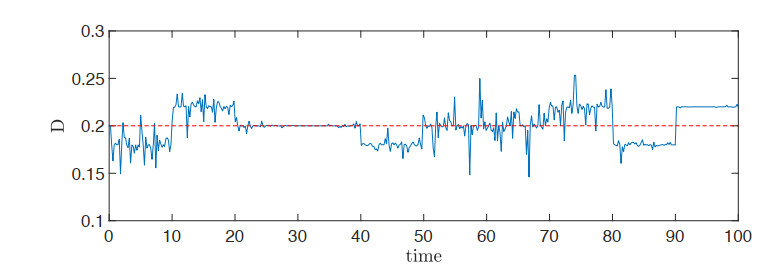
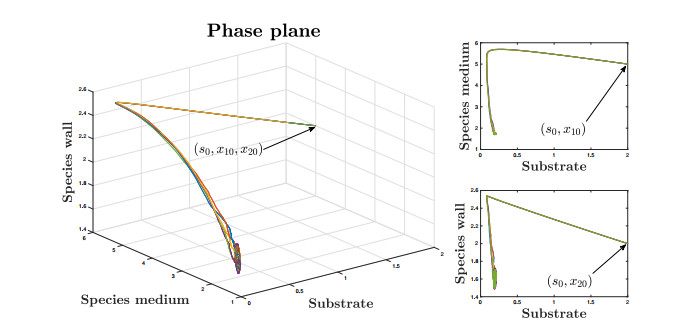
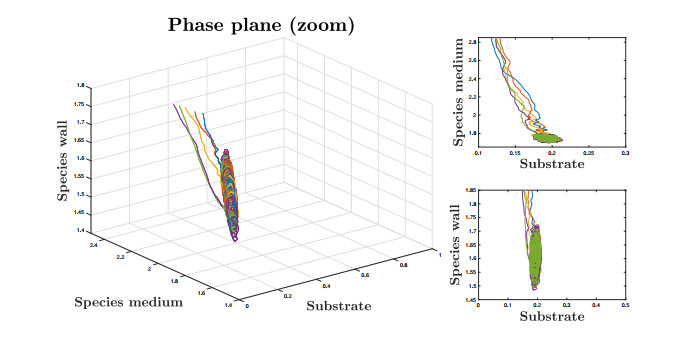
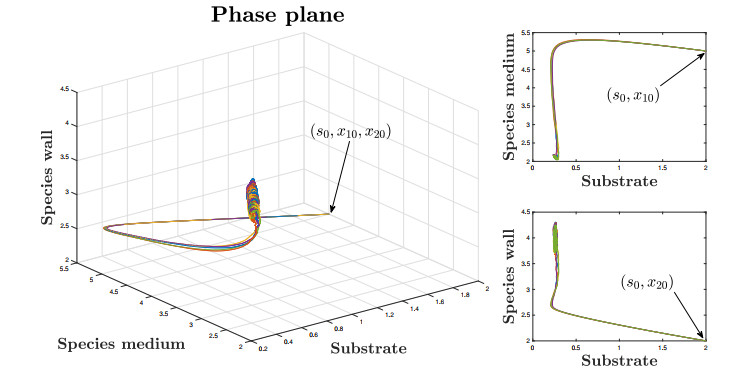
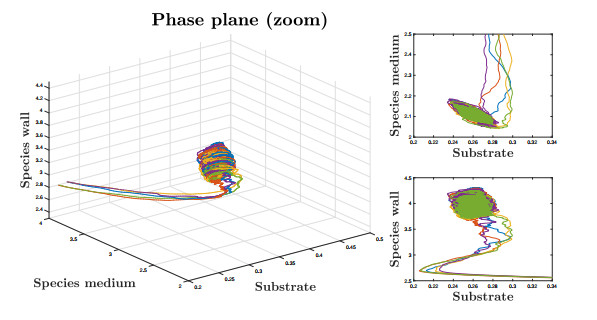
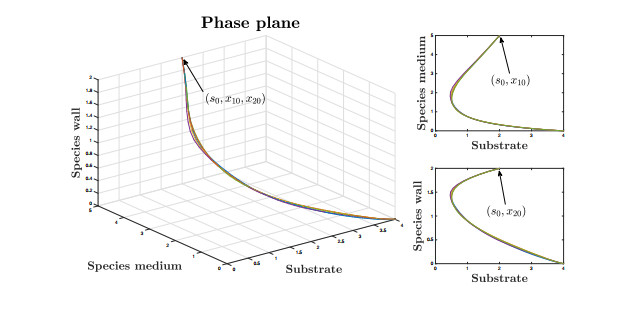
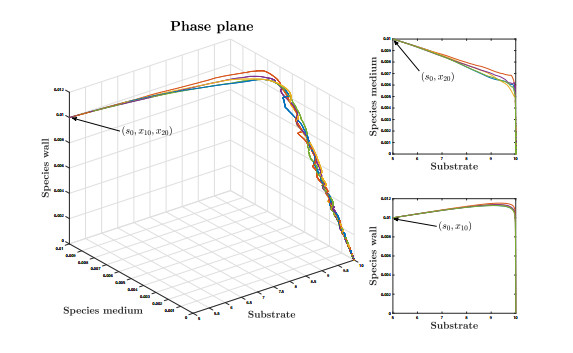
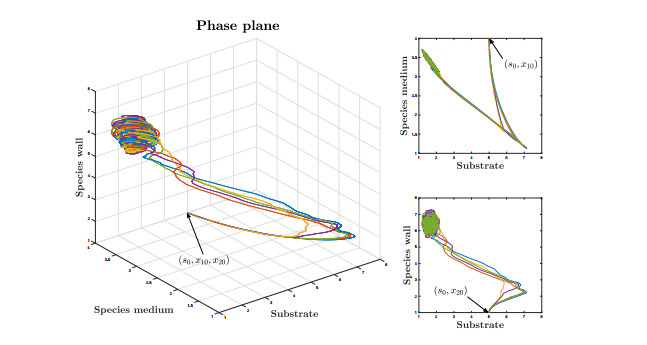
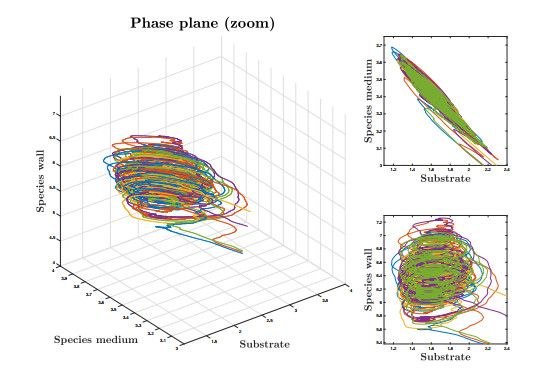


 DownLoad:
DownLoad: